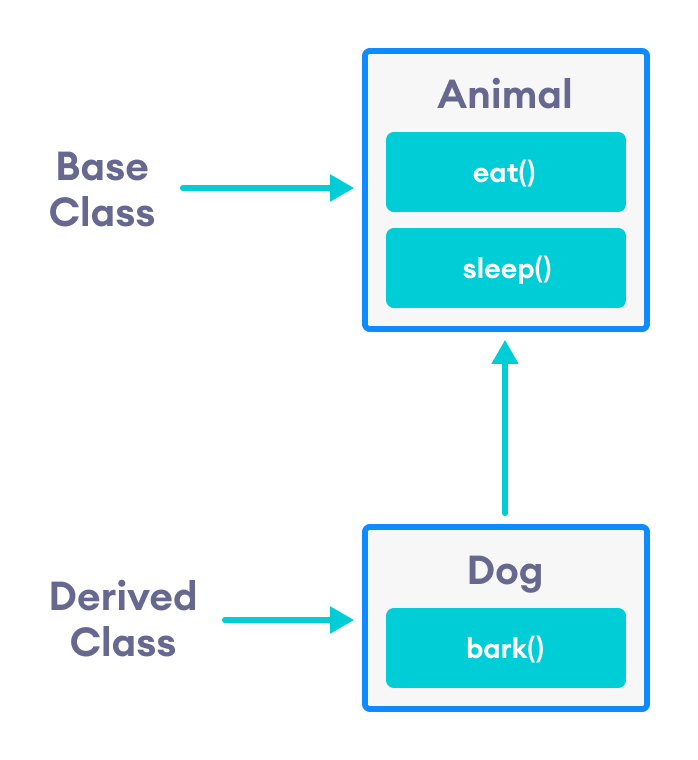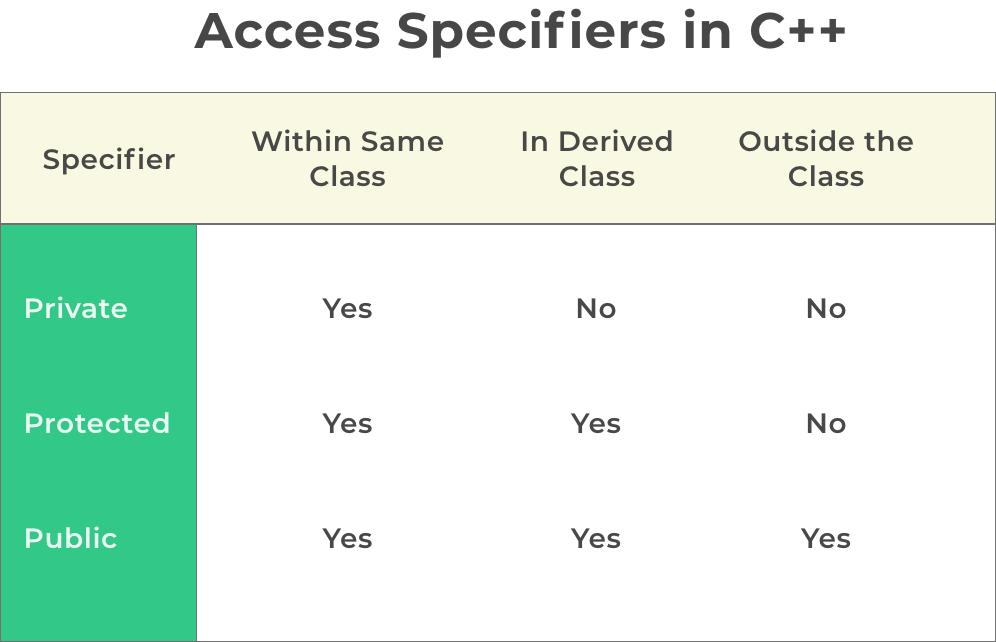module03 - achrafelkhnissi/CPP_Modules GitHub Wiki
Table of content
- inheritance introduction
- inheritance in classes
- "is a" test and "has a" test
- access specifier (base class & class members)
- multiple inheritance
- The diamond problem
- Resources
inheritance introduction
- Inheritance is the means by which you can create new classes by reusing and expanding on existing class definitions.
- Inheritance is also fundamental to making
polymorphismpossible, and polymorphism is a basic feature of object-oriented programming. - One class is derived from another by adding extra properties, by specialization and making the new class a specialized version of the more general class
Introduction
// base class
class Animal {
private:
int _numberOfLegs;
public:
Animal();
Animal(Animal const &);
Animal& operator=(Animal const &);
~Animal();
void run(int distance);
void call();
void eat(std::string const & what);
void walk(int distance);
};
// It means that Cat is an animal
// public inheritance
class Cat : public Animal {
public:
Cat();
Cat(Cat const &);
Cat& operator=(Cat const &);
~Cat();
void scornSomeone(std::string const & target);
};
class Pony : public Animal {
public:
Pony();
Pony(Pony const &);
Pony& operator=(Pony const &);
~Pony();
void doMagic(std::string const & target);
void run(int distance); // it will replace the animal function
};
inheritance in classes
- A
base classis also referred to as asuperclassof a class that is derived from it and thederived classis asubclassof its base - A derived class automatically contains all the data members of its base class, and (with some restrictions) all the function members. A derived class inherits the data members and function members of its base class
base class and derived class
"is a" test and "has a" test
- Derived class objects should be
sensible specialisationsof base class objects. It means that a derived class should define a subset of the objects that are represented by the base class. - The
"is a"test is an excellent first check, but it's not infallible. If classes fail the "is a" test, then you almost certainly shouldn't use class derivation. In this case, you could check the"has a"test - A class object passes the
"has a"test if it contains an instance of another class. You can accommodate this by including an object to the second class as a data member of the first. For instance, anAutomobileobject would have anEngineobject as a data member. This type of relationship is calledaggregation.
access specifier (base class & class members)
- It determines how the members of the base class can be accessed within the derived class
private: members are totally private to the class. Not only can they not be accessed from outside of the base class, they also cannot be accessed from inside a class that inherits themprotected: members of a base class is accessible from within the derived class, but protected from outside interference- Access to inherited members of a derived class object is not only determined by their access specification in the base class, but by both the access specifier in the base class and the access specifier of the base class in the derived class
Example of access specifier for class members
class Quadruped { // Can access name, run() and legs
private:
std::string name; // Only accessible from an Quadruped object
protected:
Leg legs[4]; // Accessible from an Quadruped or derived object
public:
void run(); // Accessible from wherever
};
-
In general, there are three possibilities for the base class specifier:
public,protected,private. If you omit the base base access specifier, the default isprivate -
Being able to change the access level of inherited members in a derived class gives you a degree of flexibility, but remember that you can only make the access level more stringent, you can't relax the access level that is specifier in the base class
Effect of the base class specifier on the accessibility of inherited members
- In summary, you need to consider two aspects when defining a hierarchy of classes: the access specifiers for the members of each class, and the base class access specifier in each derived class
multiple inheritance
- A derived class can have as many direct base classes as an application requires. This is referred to as
multiple inheritanceas opposed tosingle inheritance, in which a single base class is used. Multiple inheritance is used much less frequently than single inheritance and in best avoided as much as possible.
An example of multiple inheritance
class CerealPack : public Carton, public Contents
{
// details of the class...
};
-
The CerealPack class will inherit all the members of both base classes, so this will include the members of the indirect base, Box. The constructors of inherited classes are called in the same order in which they are inherited. In this case,
Carton's constructor will be called beforeContents' constructor -
The access level of each inherited member is determined by two factors:
the access specifier of the member in the base classandthe base class access specifier.
Virtual base classes
- To avoid duplication of a base class, you must identify to the compiler that the base class should only appear once within a derived class. You do this by specifying the class as a
virtual base classusing thevirtualkeyword.
The diamond problem
-
The diamond problem occurs when two superclasses of a class have a common base class. For example, in the following diagram, the TA class gets two copies of all attributes of Person class, this causes ambiguities.
-
The solution to this problem is ‘virtual’ keyword. We make the classes ‘Faculty’ and ‘Student’ as virtual base classes to avoid two copies of ‘Person’ in ‘TA’ class.
- How does virtual solve the diamond problem? Virtual inheritance means that there will be only 1 instance of the base A class not 2. (source)




